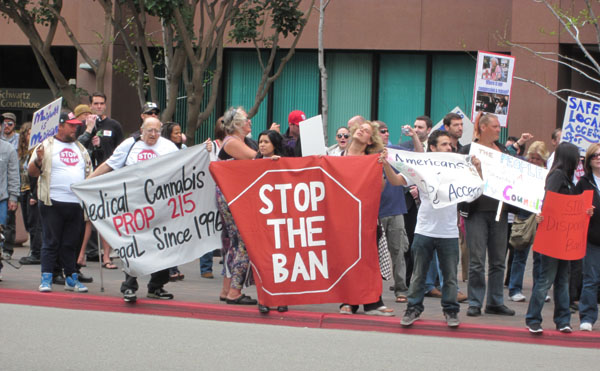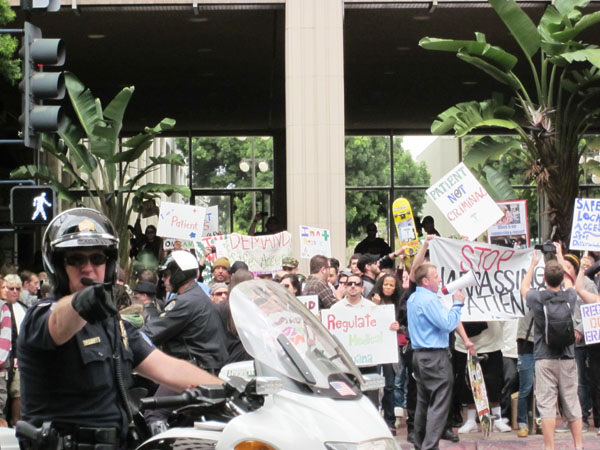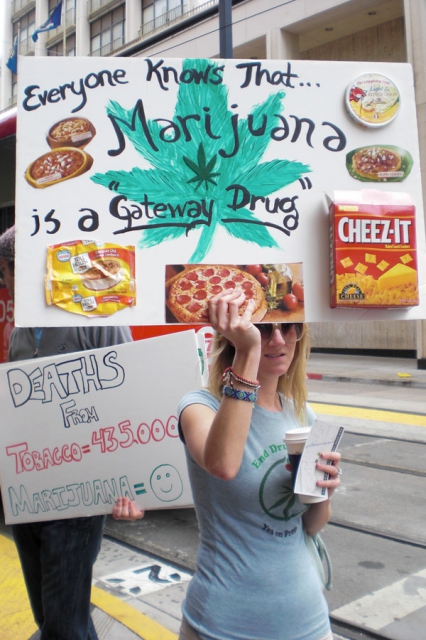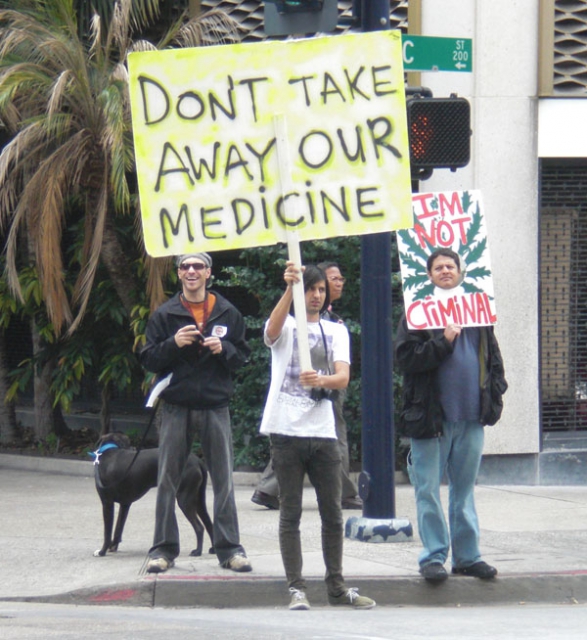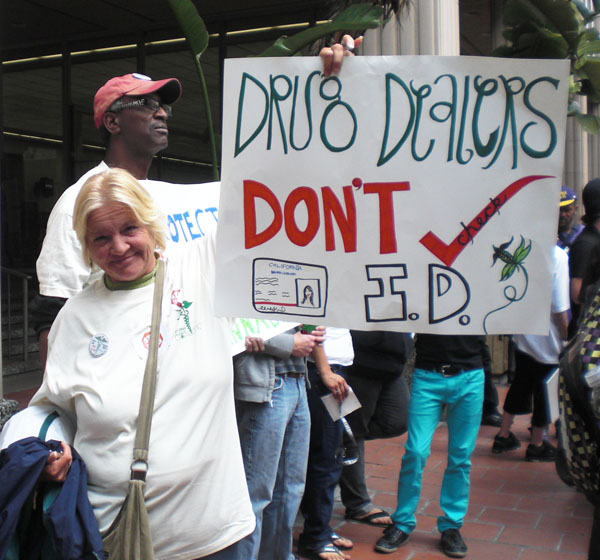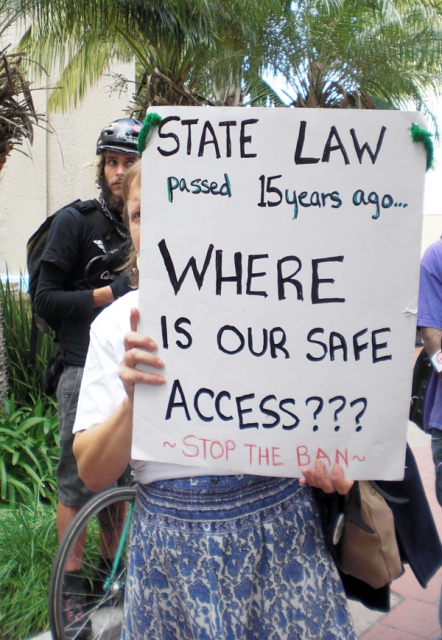From the Open-Publishing Calendar
From the Open-Publishing Newswire
Indybay Feature
California
San Diego
Drug War
Government & Elections
Health, Housing & Public Services
Police State & Prisons
San Diego Hammers Down on Medical Marijuana Dispensaries, Despite Public Support
Despite overwhelming public input asking for a looser ordinance that would allow medical marijuana dispensaries to locate in commercial areas throughout San Diego and remain open while they pursued permits, the San Diego City Council voted 5-2 on Monday, March 26 for an ordinance that will close down all dispensaries for at least a year and force them to locate only in industrial zones — inconveniently far from the patients they serve. Even most of the Councilmembers who voted for the ordinance, which was tweaked at the last minute to make it slightly less restrictive, made it clear that they regard medical marijuana patients and the institutions that serve them as a detriment, not an asset, to the city.
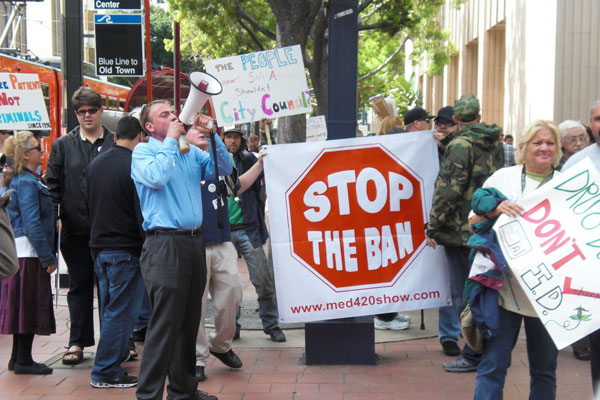
City Council Votes to Restrict Marijuana Dispensaries
Despite Public Pressure, Virtual Ban Passes with Slight Amendments
by MARK GABRISH CONLAN
Copyright © 2011 by Mark Gabrish Conlan for Zenger’s Newsmagazine • All rights reserved
Photos © 2011 by Mark Gabrish Conlan and Charles Nelson. All rights reserved
The San Diego City Council spent nearly six hours on Monday, March 28 listening to public input and debating a proposed permit process for medical marijuana dispensaries — and passed, with only slight changes, a measure that dispensary members and their supporters say amounts to a virtual ban. Though public speakers in support of giving medical marijuana users safe access to the substance through collectives far outnumbered opponents at each stage of the process — at the Planning Commission and the City Council’s committees as well as the Council itself — the Council listened to the voices of advocates of the so-called “war on drugs” and enacted an ordinance that would make it virtually impossible for dispensaries to locate anywhere in the city of San Diego.
Medical marijuana supporters — including patients who use dispensaries as well as their managers and attorneys, as well as volunteer activists — organized a massive campaign they called “Stop the Ban” to try to get the Council to adopt a looser regulation along the lines suggested by the Council’s Medical Marijuana Task Force. They packed the hearings before the Planning Commission and Council committees. They got constituents to write up to 3,000 letters to Councilmembers — the largest letter-writing campaign directed at the Council, according to organizer Ben Cisneros. And they staged a demonstration on the day of the Council meeting that drew up to 500 people, beginning at the Federal Building downtown and moving to the outside of San Diego City Hall. But the Council was clearly more attuned to the arguments of opponents that the medical marijuana laws are being abused by recreational users and that dispensaries are bad for the communities in which they are located.
The ordinance before the City Council would have limited dispensaries to industrial zones and a handful of commercial zones. It would have put dispensaries through the most severe permitting process required under city law — Process 4, which also covers new airports and mines. And it would have required that dispensaries be located at least 1,000 feet from schools, playgrounds, libraries, child care facilities, youth facilities, churches, parks and other dispensaries. Acting on a motion from District 3 Councilmember Todd Gloria, the Council cut the 1,000-foot distance to 600 feet and changed the permit requirement to the less onerous Process 3.
But they did nothing to change what dispensary advocates considered the most serious restriction in the proposed ordinance: the severe limits on just which zones dispensaries can locate in the city. They also didn’t change the part of the ordinance that requires all existing dispensaries to close before they can start the permitting process — which, advocates said, means that medical marijuana patients could have to wait up to a year or more before having safe access to the substance.
The new rules would keep dispensaries away from any areas in the city where people actually live and force them into areas well away from public transportation — a major hardship for sick people, especially ones whose illnesses make it impossible for them to drive. “For many sick patients, travel is difficult,” said Eugene Davidovich, local liaison to the nationwide medical marijuana organization Americans for Safe Access. “It is unnecessary and divisive to restrict [dispensaries] to industrial areas. This makes it impossible for them to locate within the city limits.”
“I don’t think you should be taking the collectives from downtown,” said medical marijuana patient Michael Corbett. “I have to use public transportation to get around, and it takes three and one-half hours to get there [to an industrial zone] and back. I’m a Viet Nam vet with post-traumatic stress disorder (PTSD), chronic depression and arthritis. The medical marijuana helps me quite a bit, especially with my sleep apnea.” Corbett also warned that if medical marijuana users have to travel long distances to obtain the substance, criminals will target them. “I’ve had people follow me and wait for me,” he said. “If [my dispensary] were in an industrial area, I’d probably get jumped for my product.”
“The new ordinance will make access so restrictive, patients either won’t get their medicine or will have to go to the black market,” said marijuana dispensary director James Schmucktenberger. “If this ordinance passes, [my client] Linda will either not have medicine or will have to drive miles out of her way, which she is physically incapable of.”
“My father was on oxygen a few years ago,” said collective supporter Brianna Lenville. “I saw him take [pharmaceutical] drugs that made him sicker. Without medical cannabis [marijuana] he probably wouldn’t be here today. Think about the patients and their families, and what they will lose, before you vote to take away safe access.”
The controversy over dispensaries is just the latest wrinkle in the ongoing contention over medical marijuana since November 1996, when Californians became the first voters in the U.S. to allow the use of marijuana for medical reasons. Dale Gieringer, who was one of the authors of the medical marijuana initiative, Proposition 215, spoke to the City Council and said, “I’m surprised that it’s taken so long for the state to implement the law.” Among the issues involved are the continued ban on all uses of marijuana from the federal government — which gives agents of the U.S. Drug Enforcement Administration (DEA) the authority to raid medical marijuana collectives in California and other states that have laws allowing medical use.
In more liberal cities like San Francisco, local governments have refused to allow local police to cooperate with DEA raids against medical marijuana dispensaries and gardens as long as the patient collectives who operated them were legal by state and local standards. In San Diego, the city police and county sheriff’s department have frequently worked with DEA agents to raid medical marijuana facilities. In 2009 President Obama’s attorney general, Eric Holder, promised that he would stop the DEA from raiding medical marijuana facilities where state laws allowed them — but the raids have continued anyway.
“No city has successfully regulated medical marijuana dispensaries with rules as restrictive as these,” Gieringer told the San Diego City Council. He held up his own city, Oakland, as an example for San Diego to follow. “We did it not by taking them out of commercial zones,” he said. “We had city staff look through the properties, accept those that looked good and reject those that looked bad, and we haven’t had problems since. Sacramento, San Francisco and West Hollywood, California, and Denver, Colorado, all have successfully regulated dispensaries by allowing them in commercial zones.”
Stephen Whitburn, a former candidate for the San Diego City Council (he lost to Todd Gloria) and the San Diego County Board of Supervisors, and a member of the city’s Medical Marijuana Task Force, suggested that the ordinance should be more along the lines of what the task force originally recommended. That would essentially have treated medical marijuana dispensaries similarly to pharmacies, allowing them to locate in all commercial areas. It would have followed state law in keeping them 600 feet from schools or other dispensaries, but would not have had the more severe restrictions that got written into the city ordinance after the task force recommended it.
Like Gieringer, Whitburn acknowledged that there are “good” and “bad” dispensaries — ones that take the medical mission seriously and others that operate as fronts to service people who want to use the drug recreationally — and he said the best way for the city to separate the wheat from the chaff would be to allow local community planning groups to do it. “Different neighborhoods have different issues around medical marijuana, and planning groups want a voice,” Whitburn explained. “In District 3 a lot of people want them. Many people there know people who have benefited from medical marijuana. In District 4 there are concerns that dispensaries would add more challenges. In other districts there’s more imbalance. In District 2, some of the most vocal opponents to dispensaries come from Pacific Beach and some of the most vocal supporters come from Ocean Beach.”
Whitburn argued that the city should pass a minimally restrictive ordinance and let neighborhood planning groups decide, on a case-by-case basis, how many dispensaries can locate in their areas and which operators they will allow. “If a planning group thinks a dispensary is proper, fine,” Whitburn explained. “If not, fine. We should give the neighborhoods a say.”
Rev. Mary Moreno Richardson of St. Paul’s Episcopal Cathedral near Balboa Park — speaking for herself and not for her church or denomination — gave an impassioned defense of dispensaries and made it clear she’s one minister who doesn’t want them kept away from churches. “For 25 years I’ve worked in social services in Santa Barbara, Los Angeles and San Diego,” she said. “I serve as a chaplain with incarcerated youth and [people convicted of] trafficking. I have seen the destruction of drugs — and also the destruction from the ‘war on drugs.’ This is a war against the poor, sick and disabled.”
Richardson announced that the California Council of Churches, on whose board she sits, opposed the ordinance “because rezoning to limit medical marijuana [dispensaries] is detrimental to people with real medical needs. If there are abuses, deal with those. Compassion for people with diseases and in pain is part of the common good. This ban would affect the most vulnerable people in our community. … I have seen first-hand the benefits of medical marijuana for people, including senior citizens, who are living in chronic pain. I know one 80-year-old woman who was in pain from a fall and could not take prescription drugs because they made her nauseous. She tried medical marijuana lotion, which gave her incredible relief. … I believe we should have collectives near churches because they help relieve suffering.”
Ben Cisneros, a City Heights resident and medical marijuana advocate, noted that the proposed ordinance was so restrictive the city’s planning department hadn’t been able to come up with a map showing where dispensaries could locate legally under it. “Medical marijuana dispensaries have broad support throughout California and contribute to the community,” he said. “At every hearing, supporters [of dispensaries] have far outnumbered opponents. … If this ordinance passes, many San Diegans will turn either to pharmaceuticals or to the black market, and crime will increase.”
Gieringer, Davidovich and Corbett also talked about one little-discussed aspect of the dispensary issues: the amount of money they raise for the city’s parched coffers by charging sales tax. “In San Diego, we have between 25,000 and 60,000 legal patients, and that’s $10-20 million in taxes,” Gieringer explained. “If San Diego tries to close all the clubs, they will lose money and lose jobs, and you will be dragged down in litigation, just as you were in 2005 when the courts overturned your decision on adult entertainment facilities.”
The Opposition
The speakers against medical marijuana — some of whom wanted to see the ordinance pass without amendments and some of whom wanted it even more restrictive — generally either argued against the medical use of marijuana itself, often saying it sends “a mixed message” to teenagers considering recreational use, or said that dispensaries attract crime to the neighborhoods they’re in by giving criminals easy targets. Scott Shipman, representing a group called San Diegans for Safe Neighborhoods, said that his organization’s position is “in favor of regulations that would prohibit [offering] marijuana for sale.”
According to Shipman, nothing in Proposition 215 allows businesses to sell marijuana. The state law governing dispensaries requires that they be organized as nonprofit collectives or cooperatives, but Shipman said that’s just a façade. “There’s no doubt that these stores are businesses,” he explained. “These stores are increasing recreational drug use. Many counties and cities are seeing the harm in these stores and are prohibiting them. According to an article in the Arizona Sun, less than 2 percent of the people who use these stores have serious illnesses like cancer or AIDS.” Shipman said that the city should ban dispensaries completely, or if it doesn’t do that it should at least add colleges and universities to the list of institutions dispensaries must be at least 1,000 feet from — a restriction actually considered in the council committee process, but ultimately dropped.
“I live in District 2, I’m the mother of two teenagers and I’m concerned that these [dispensaries] are encouraging my kids to accept marijuana use,” said Marcy Beckett. “The shops are selling to recreational users, and that is affecting our communities. For $40, anyone can get a doctor’s recommendation, and then they can buy from these stores and sell it to anyone, including our kids. This is back-door legalization, and we voted against that last November” — referring to Proposition 19, defeated by California voters last fall (and, ironically, opposed by some people involved in growing medical marijuana who feared it would hurt their business).
“As a professor at San Diego State University (SDSU), I’m concerned about youngsters,” said Shirley Forbing. “I am all for people who need [medical marijuana] and are supported by their primary physicians.” Forbing’s main argument was that, because the human brain is still developing until a person is about 25, no one younger than that should be allowed to use marijuana for any reason. She also said that “marijuana has 423 chemicals, and over 2,000 when combusted,” and that the percentage of tetrahydrocannabinol (THC), the component mostly responsible for marijuana’s euphoric (or “high”) effect, has increased in the last 10 years from 2.2 to 9.5 percent — a claim that drew groans from the medical marijuana supporters in the audience.
The most spectacular arguments against allowing dispensaries came from a tall, white-haired man named Royal Magnus, who introduced himself as a former police officer and prison counselor who now works in substance abuse prevention. “In the back of the line of people coming forward to attend this meeting I saw 15 people smoking grass,” he said. “They are arrogant troublemakers and I don’t want them in my neighborhood.” He told the Councilmembers to “use logic” while admitting that “I speak emotionally.” He said that if dispensaries are allowed in San Diego, “crime will increase and people will die. That’s what they told me when I was packing a gun. It’s the arrogance of the community behind it.” After claiming to have closed down a meth lab by reporting its proprietors on child abuse charges, Magnus leveled an attack on sex researcher Dr. Alfred Kinsey, calling him a pervert who rigged his researches to justify his own perversions and started the breakdown in morality that led to the approval of medical marijuana use.
The Council
After hearing over five hours of public comment, Councilmember Gloria led off the Council’s debate by acknowledging that, while the ordinance as written “reflects community input, some of the regulations are unduly restrictive.” Though he said he was “concerned that there was no grace period for existing cooperatives” — no time to allow them to remain in operation while they comply with the new regulations — ultimately he did not push the issue with his fellow Councilmembers.
Councilmember Marti Emerald noted that the Council was actually considering two separate ordinances — one dealing with land use and zoning, the other with public safety — and asked for a clarification that a dispensary would have to prove they were in compliance with both before they could open. “This is not a ban,” Emerald insisted. “It’s going to impact the number of facilities open, but the folks who will still have their doors open will be those who play by the rules and won’t make their patients subject to raids.”
“This issue is a contentious one,” said Council president Tony Young. “We’ve got a federal government that does not support the state law and believes we are breaking the law by allowing this to exist in our city. I don’t believe it will work unless the state and federal governments are on the same plane. I also want to make sure that people who need the medicine are able to get it. None of you addressed the issue that medical marijuana is very easy to get for people who don’t need it, and that’s a problem” — ignoring supporters of medical marijuana like Richardson and Whitburn, who had acknowledged that problem and called for a more flexible ordinance to allow legitimate dispensaries to operate while closing down others.
Throughout his remarks, Young repeatedly said, “I know that’s true,” representing himself as knowing more about the issue than the patients, the dispensary owners and others directly involved in it. “I deal with young people all the time and see young people who have their [medical marijuana] cards. Sometimes they go to these facilities to get medical pot and sometimes the pot they have on their persons is for the streets. We do want to make sure these operations don’t proliferate to the point where they’re unmanageable. Right now we have two facilities in District 4 and two others we had to shut down because they weren’t operating in ways conducive to our community.”
Though he seconded Gloria’s motion and ultimately voted for it, Young seemed more interested in scoring points against the medical marijuana community than in supporting it. “The way the industry has comported itself in its ads have not presented the industry very well,” he said. “The ads have said if you don’t need it medically, you can still get a card. Cards are too easy to get. You can get one over the Internet or over the phone, and that’s something we can’t regulate.” Young made it clear he was voting for the ordinance because without a city law in place, “tomorrow we might have 180 [dispensaries] and the next week we’ll have 265. I will support the motion, but it’s not in the best interests of San Diego.”
The two medical marijuana dispensary ordinances both passed 5-2, with Councilmember David Alvarez absent and Carl DeMaio and Lorie Zapf opposed. Both DeMaio and Zapf made it clear that they voted against the ordinances because they didn’t find them restrictive enough, and DeMaio — whose signature issue, both as a Councilmember and a prospective candidate for mayor of San Diego — also said he was worried about the cost to the city of regulating dispensaries. “We cannot keep adopting programs we have no way to pay for,” he said — not answering but just ignoring the supporters’ argument that dispensaries actually bring tax money into the city’s treasury.
DeMaio also made it clear he’s against medical marijuana on principle except for the most serious health conditions. When Proposition 215 was on the ballot, he said, “California voters were told it would only be for people who were severely ill or in acute pain. The initiative has been abused for the purpose of obtaining marijuana for recreational use, and if you won’t admit that we’re not in the same spot.” He also said that Gloria’s amendments “actually weaken our obligation to protect neighborhoods. With over 165 dispensaries [citywide], I hear from my constituents that we already have too many.”
“This ordinance has severe flaws,” said Zapf. “I wanted to see universities in there [as places dispensaries could not be located near]. One-half of the people buying medical marijuana are between 18 and 29. My first and foremost concerns are safe children and preserving communities. My staff estimated that at least 90 percent of the potentially vacant sites [available for dispensaries under the ordinance] are in my district” — which, if true, would seem to argue for a less restrictive ordinance that would have allowed dispensaries in more areas of the city. “I can’t support turning my district into a ‘pot district’,” Zapf concluded.
Despite Public Pressure, Virtual Ban Passes with Slight Amendments
by MARK GABRISH CONLAN
Copyright © 2011 by Mark Gabrish Conlan for Zenger’s Newsmagazine • All rights reserved
Photos © 2011 by Mark Gabrish Conlan and Charles Nelson. All rights reserved
The San Diego City Council spent nearly six hours on Monday, March 28 listening to public input and debating a proposed permit process for medical marijuana dispensaries — and passed, with only slight changes, a measure that dispensary members and their supporters say amounts to a virtual ban. Though public speakers in support of giving medical marijuana users safe access to the substance through collectives far outnumbered opponents at each stage of the process — at the Planning Commission and the City Council’s committees as well as the Council itself — the Council listened to the voices of advocates of the so-called “war on drugs” and enacted an ordinance that would make it virtually impossible for dispensaries to locate anywhere in the city of San Diego.
Medical marijuana supporters — including patients who use dispensaries as well as their managers and attorneys, as well as volunteer activists — organized a massive campaign they called “Stop the Ban” to try to get the Council to adopt a looser regulation along the lines suggested by the Council’s Medical Marijuana Task Force. They packed the hearings before the Planning Commission and Council committees. They got constituents to write up to 3,000 letters to Councilmembers — the largest letter-writing campaign directed at the Council, according to organizer Ben Cisneros. And they staged a demonstration on the day of the Council meeting that drew up to 500 people, beginning at the Federal Building downtown and moving to the outside of San Diego City Hall. But the Council was clearly more attuned to the arguments of opponents that the medical marijuana laws are being abused by recreational users and that dispensaries are bad for the communities in which they are located.
The ordinance before the City Council would have limited dispensaries to industrial zones and a handful of commercial zones. It would have put dispensaries through the most severe permitting process required under city law — Process 4, which also covers new airports and mines. And it would have required that dispensaries be located at least 1,000 feet from schools, playgrounds, libraries, child care facilities, youth facilities, churches, parks and other dispensaries. Acting on a motion from District 3 Councilmember Todd Gloria, the Council cut the 1,000-foot distance to 600 feet and changed the permit requirement to the less onerous Process 3.
But they did nothing to change what dispensary advocates considered the most serious restriction in the proposed ordinance: the severe limits on just which zones dispensaries can locate in the city. They also didn’t change the part of the ordinance that requires all existing dispensaries to close before they can start the permitting process — which, advocates said, means that medical marijuana patients could have to wait up to a year or more before having safe access to the substance.
The new rules would keep dispensaries away from any areas in the city where people actually live and force them into areas well away from public transportation — a major hardship for sick people, especially ones whose illnesses make it impossible for them to drive. “For many sick patients, travel is difficult,” said Eugene Davidovich, local liaison to the nationwide medical marijuana organization Americans for Safe Access. “It is unnecessary and divisive to restrict [dispensaries] to industrial areas. This makes it impossible for them to locate within the city limits.”
“I don’t think you should be taking the collectives from downtown,” said medical marijuana patient Michael Corbett. “I have to use public transportation to get around, and it takes three and one-half hours to get there [to an industrial zone] and back. I’m a Viet Nam vet with post-traumatic stress disorder (PTSD), chronic depression and arthritis. The medical marijuana helps me quite a bit, especially with my sleep apnea.” Corbett also warned that if medical marijuana users have to travel long distances to obtain the substance, criminals will target them. “I’ve had people follow me and wait for me,” he said. “If [my dispensary] were in an industrial area, I’d probably get jumped for my product.”
“The new ordinance will make access so restrictive, patients either won’t get their medicine or will have to go to the black market,” said marijuana dispensary director James Schmucktenberger. “If this ordinance passes, [my client] Linda will either not have medicine or will have to drive miles out of her way, which she is physically incapable of.”
“My father was on oxygen a few years ago,” said collective supporter Brianna Lenville. “I saw him take [pharmaceutical] drugs that made him sicker. Without medical cannabis [marijuana] he probably wouldn’t be here today. Think about the patients and their families, and what they will lose, before you vote to take away safe access.”
The controversy over dispensaries is just the latest wrinkle in the ongoing contention over medical marijuana since November 1996, when Californians became the first voters in the U.S. to allow the use of marijuana for medical reasons. Dale Gieringer, who was one of the authors of the medical marijuana initiative, Proposition 215, spoke to the City Council and said, “I’m surprised that it’s taken so long for the state to implement the law.” Among the issues involved are the continued ban on all uses of marijuana from the federal government — which gives agents of the U.S. Drug Enforcement Administration (DEA) the authority to raid medical marijuana collectives in California and other states that have laws allowing medical use.
In more liberal cities like San Francisco, local governments have refused to allow local police to cooperate with DEA raids against medical marijuana dispensaries and gardens as long as the patient collectives who operated them were legal by state and local standards. In San Diego, the city police and county sheriff’s department have frequently worked with DEA agents to raid medical marijuana facilities. In 2009 President Obama’s attorney general, Eric Holder, promised that he would stop the DEA from raiding medical marijuana facilities where state laws allowed them — but the raids have continued anyway.
“No city has successfully regulated medical marijuana dispensaries with rules as restrictive as these,” Gieringer told the San Diego City Council. He held up his own city, Oakland, as an example for San Diego to follow. “We did it not by taking them out of commercial zones,” he said. “We had city staff look through the properties, accept those that looked good and reject those that looked bad, and we haven’t had problems since. Sacramento, San Francisco and West Hollywood, California, and Denver, Colorado, all have successfully regulated dispensaries by allowing them in commercial zones.”
Stephen Whitburn, a former candidate for the San Diego City Council (he lost to Todd Gloria) and the San Diego County Board of Supervisors, and a member of the city’s Medical Marijuana Task Force, suggested that the ordinance should be more along the lines of what the task force originally recommended. That would essentially have treated medical marijuana dispensaries similarly to pharmacies, allowing them to locate in all commercial areas. It would have followed state law in keeping them 600 feet from schools or other dispensaries, but would not have had the more severe restrictions that got written into the city ordinance after the task force recommended it.
Like Gieringer, Whitburn acknowledged that there are “good” and “bad” dispensaries — ones that take the medical mission seriously and others that operate as fronts to service people who want to use the drug recreationally — and he said the best way for the city to separate the wheat from the chaff would be to allow local community planning groups to do it. “Different neighborhoods have different issues around medical marijuana, and planning groups want a voice,” Whitburn explained. “In District 3 a lot of people want them. Many people there know people who have benefited from medical marijuana. In District 4 there are concerns that dispensaries would add more challenges. In other districts there’s more imbalance. In District 2, some of the most vocal opponents to dispensaries come from Pacific Beach and some of the most vocal supporters come from Ocean Beach.”
Whitburn argued that the city should pass a minimally restrictive ordinance and let neighborhood planning groups decide, on a case-by-case basis, how many dispensaries can locate in their areas and which operators they will allow. “If a planning group thinks a dispensary is proper, fine,” Whitburn explained. “If not, fine. We should give the neighborhoods a say.”
Rev. Mary Moreno Richardson of St. Paul’s Episcopal Cathedral near Balboa Park — speaking for herself and not for her church or denomination — gave an impassioned defense of dispensaries and made it clear she’s one minister who doesn’t want them kept away from churches. “For 25 years I’ve worked in social services in Santa Barbara, Los Angeles and San Diego,” she said. “I serve as a chaplain with incarcerated youth and [people convicted of] trafficking. I have seen the destruction of drugs — and also the destruction from the ‘war on drugs.’ This is a war against the poor, sick and disabled.”
Richardson announced that the California Council of Churches, on whose board she sits, opposed the ordinance “because rezoning to limit medical marijuana [dispensaries] is detrimental to people with real medical needs. If there are abuses, deal with those. Compassion for people with diseases and in pain is part of the common good. This ban would affect the most vulnerable people in our community. … I have seen first-hand the benefits of medical marijuana for people, including senior citizens, who are living in chronic pain. I know one 80-year-old woman who was in pain from a fall and could not take prescription drugs because they made her nauseous. She tried medical marijuana lotion, which gave her incredible relief. … I believe we should have collectives near churches because they help relieve suffering.”
Ben Cisneros, a City Heights resident and medical marijuana advocate, noted that the proposed ordinance was so restrictive the city’s planning department hadn’t been able to come up with a map showing where dispensaries could locate legally under it. “Medical marijuana dispensaries have broad support throughout California and contribute to the community,” he said. “At every hearing, supporters [of dispensaries] have far outnumbered opponents. … If this ordinance passes, many San Diegans will turn either to pharmaceuticals or to the black market, and crime will increase.”
Gieringer, Davidovich and Corbett also talked about one little-discussed aspect of the dispensary issues: the amount of money they raise for the city’s parched coffers by charging sales tax. “In San Diego, we have between 25,000 and 60,000 legal patients, and that’s $10-20 million in taxes,” Gieringer explained. “If San Diego tries to close all the clubs, they will lose money and lose jobs, and you will be dragged down in litigation, just as you were in 2005 when the courts overturned your decision on adult entertainment facilities.”
The Opposition
The speakers against medical marijuana — some of whom wanted to see the ordinance pass without amendments and some of whom wanted it even more restrictive — generally either argued against the medical use of marijuana itself, often saying it sends “a mixed message” to teenagers considering recreational use, or said that dispensaries attract crime to the neighborhoods they’re in by giving criminals easy targets. Scott Shipman, representing a group called San Diegans for Safe Neighborhoods, said that his organization’s position is “in favor of regulations that would prohibit [offering] marijuana for sale.”
According to Shipman, nothing in Proposition 215 allows businesses to sell marijuana. The state law governing dispensaries requires that they be organized as nonprofit collectives or cooperatives, but Shipman said that’s just a façade. “There’s no doubt that these stores are businesses,” he explained. “These stores are increasing recreational drug use. Many counties and cities are seeing the harm in these stores and are prohibiting them. According to an article in the Arizona Sun, less than 2 percent of the people who use these stores have serious illnesses like cancer or AIDS.” Shipman said that the city should ban dispensaries completely, or if it doesn’t do that it should at least add colleges and universities to the list of institutions dispensaries must be at least 1,000 feet from — a restriction actually considered in the council committee process, but ultimately dropped.
“I live in District 2, I’m the mother of two teenagers and I’m concerned that these [dispensaries] are encouraging my kids to accept marijuana use,” said Marcy Beckett. “The shops are selling to recreational users, and that is affecting our communities. For $40, anyone can get a doctor’s recommendation, and then they can buy from these stores and sell it to anyone, including our kids. This is back-door legalization, and we voted against that last November” — referring to Proposition 19, defeated by California voters last fall (and, ironically, opposed by some people involved in growing medical marijuana who feared it would hurt their business).
“As a professor at San Diego State University (SDSU), I’m concerned about youngsters,” said Shirley Forbing. “I am all for people who need [medical marijuana] and are supported by their primary physicians.” Forbing’s main argument was that, because the human brain is still developing until a person is about 25, no one younger than that should be allowed to use marijuana for any reason. She also said that “marijuana has 423 chemicals, and over 2,000 when combusted,” and that the percentage of tetrahydrocannabinol (THC), the component mostly responsible for marijuana’s euphoric (or “high”) effect, has increased in the last 10 years from 2.2 to 9.5 percent — a claim that drew groans from the medical marijuana supporters in the audience.
The most spectacular arguments against allowing dispensaries came from a tall, white-haired man named Royal Magnus, who introduced himself as a former police officer and prison counselor who now works in substance abuse prevention. “In the back of the line of people coming forward to attend this meeting I saw 15 people smoking grass,” he said. “They are arrogant troublemakers and I don’t want them in my neighborhood.” He told the Councilmembers to “use logic” while admitting that “I speak emotionally.” He said that if dispensaries are allowed in San Diego, “crime will increase and people will die. That’s what they told me when I was packing a gun. It’s the arrogance of the community behind it.” After claiming to have closed down a meth lab by reporting its proprietors on child abuse charges, Magnus leveled an attack on sex researcher Dr. Alfred Kinsey, calling him a pervert who rigged his researches to justify his own perversions and started the breakdown in morality that led to the approval of medical marijuana use.
The Council
After hearing over five hours of public comment, Councilmember Gloria led off the Council’s debate by acknowledging that, while the ordinance as written “reflects community input, some of the regulations are unduly restrictive.” Though he said he was “concerned that there was no grace period for existing cooperatives” — no time to allow them to remain in operation while they comply with the new regulations — ultimately he did not push the issue with his fellow Councilmembers.
Councilmember Marti Emerald noted that the Council was actually considering two separate ordinances — one dealing with land use and zoning, the other with public safety — and asked for a clarification that a dispensary would have to prove they were in compliance with both before they could open. “This is not a ban,” Emerald insisted. “It’s going to impact the number of facilities open, but the folks who will still have their doors open will be those who play by the rules and won’t make their patients subject to raids.”
“This issue is a contentious one,” said Council president Tony Young. “We’ve got a federal government that does not support the state law and believes we are breaking the law by allowing this to exist in our city. I don’t believe it will work unless the state and federal governments are on the same plane. I also want to make sure that people who need the medicine are able to get it. None of you addressed the issue that medical marijuana is very easy to get for people who don’t need it, and that’s a problem” — ignoring supporters of medical marijuana like Richardson and Whitburn, who had acknowledged that problem and called for a more flexible ordinance to allow legitimate dispensaries to operate while closing down others.
Throughout his remarks, Young repeatedly said, “I know that’s true,” representing himself as knowing more about the issue than the patients, the dispensary owners and others directly involved in it. “I deal with young people all the time and see young people who have their [medical marijuana] cards. Sometimes they go to these facilities to get medical pot and sometimes the pot they have on their persons is for the streets. We do want to make sure these operations don’t proliferate to the point where they’re unmanageable. Right now we have two facilities in District 4 and two others we had to shut down because they weren’t operating in ways conducive to our community.”
Though he seconded Gloria’s motion and ultimately voted for it, Young seemed more interested in scoring points against the medical marijuana community than in supporting it. “The way the industry has comported itself in its ads have not presented the industry very well,” he said. “The ads have said if you don’t need it medically, you can still get a card. Cards are too easy to get. You can get one over the Internet or over the phone, and that’s something we can’t regulate.” Young made it clear he was voting for the ordinance because without a city law in place, “tomorrow we might have 180 [dispensaries] and the next week we’ll have 265. I will support the motion, but it’s not in the best interests of San Diego.”
The two medical marijuana dispensary ordinances both passed 5-2, with Councilmember David Alvarez absent and Carl DeMaio and Lorie Zapf opposed. Both DeMaio and Zapf made it clear that they voted against the ordinances because they didn’t find them restrictive enough, and DeMaio — whose signature issue, both as a Councilmember and a prospective candidate for mayor of San Diego — also said he was worried about the cost to the city of regulating dispensaries. “We cannot keep adopting programs we have no way to pay for,” he said — not answering but just ignoring the supporters’ argument that dispensaries actually bring tax money into the city’s treasury.
DeMaio also made it clear he’s against medical marijuana on principle except for the most serious health conditions. When Proposition 215 was on the ballot, he said, “California voters were told it would only be for people who were severely ill or in acute pain. The initiative has been abused for the purpose of obtaining marijuana for recreational use, and if you won’t admit that we’re not in the same spot.” He also said that Gloria’s amendments “actually weaken our obligation to protect neighborhoods. With over 165 dispensaries [citywide], I hear from my constituents that we already have too many.”
“This ordinance has severe flaws,” said Zapf. “I wanted to see universities in there [as places dispensaries could not be located near]. One-half of the people buying medical marijuana are between 18 and 29. My first and foremost concerns are safe children and preserving communities. My staff estimated that at least 90 percent of the potentially vacant sites [available for dispensaries under the ordinance] are in my district” — which, if true, would seem to argue for a less restrictive ordinance that would have allowed dispensaries in more areas of the city. “I can’t support turning my district into a ‘pot district’,” Zapf concluded.
For more information:
http://zengersmag.blogspot.com
Add Your Comments
Latest Comments
Listed below are the latest comments about this post.
These comments are submitted anonymously by website visitors.
TITLE
AUTHOR
DATE
Jesus said...
Tue, Apr 5, 2011 6:32AM
prohibition Sucks
Mon, Apr 4, 2011 11:11AM
Medical MJ is being controlled by the former status quo by controlling and limiting medMJ
Mon, Apr 4, 2011 4:45AM
We are 100% volunteer and depend on your participation to sustain our efforts!
Get Involved
If you'd like to help with maintaining or developing the website, contact us.
Publish
Publish your stories and upcoming events on Indybay.
Topics
More
Search Indybay's Archives
Advanced Search
►
▼
IMC Network


